(Upload on October 6 2023) [ 日本語 | English ]
Mount Usu / Sarobetsu post-mined peatland
From left: Crater basin in 1986 and 2006. Cottongrass / Daylily
HOME > Lecture catalog / Research summary > Glossary > Mycology > Fungal taxonomy
Progressing molecular methods to establsih the phylogenetic tree, as well as vascular plants│ │ Yeast Insect │ │ parasites │ │ │ │ EUASCOMYCETAE │ │ │ │ │ Molds │ │ │ │ │ │ ├───┴────┴─┴─┴──┘ ├─ Mushrooms │ Ascomycota Basidiomycota │ └──────────────────┘ Plants LIVING PHYLA OF THE FUNIGI KINGDOM │ │ ┌──Rhodophyta──┘ CONJUAGTING PROTIST ANCESTORS │ │Fig. Phylogeny of kingdom Fungi (Margulis 1974)
1983 ___ fungi vs bacteria |
|
Phylum Eumycota (Mycobionta) 真菌門≈ fungi + molds + yeastsSubphylum Mastigomycotina 鞭毛菌亜門(類)Vegetative organ: monocecullar or mycelial, developing mobile spores or gametesSwarmer (遊走細胞) at certain stages Flagellum: Conjugation: 1. planogametic conjugation (運動性配偶子接合)
isogamous (同形配偶) physiological anisogamy: isogamy with physiological differences between the uniting isogametes heterogamous 2. gametangial contact (配偶子単結合)3. gametangial conjugation (配偶子接合) 4. spermatization (不動精子による受精) 5. somatogamy (体細胞接合) |
Phylum Chytridiomycota ツボカビClass Chytridiomycetes ツボカビClass Oomycetes 卵菌Class Blastocladiales (厚膜嚢菌)⇒ separated to Phylum BlastocladiomycotaBlastocladiaceae (コウマクノウキン) Allomyces E. J. Butler (カワリミズカビ) Blastocladia Reinsch (コウマクノウキン): B. emersonii Catenariaceae (フシフクロカビ) Coelomomycetaceae (ボウフラキン) Physodermataceae Sorochytriaceae Phylum Zygomycota 接合菌(= Subphylum Zygomycotina 接合菌亜門, 接合菌類)⇒ polyphyletic group = disorganized establishing Phylum Glomeromycota and others Class Zygomycetes 接合菌綱Order Mucorales (ケカビ)Mucoraceae (ケカビ) (Phylum Microsporidia 微胞子虫門)Molecular phylogeny and biochemical analysis suggest that this taxon is close to ZygomycotaPhylum Ascomycota 子嚢菌Phylum Basidiomycota 担子菌Agaricales (ハラタケ)Agaricaceae Chevall. (ハラタケ)Bolbitiaceae Fr. (オキナタケ) Tricholomataceae (キシメジ) Armillaria (ナラタケ) (Phylum Glomeromycota グロムス菌)Phylum Deuteromycets 不完全菌, mitosporic fungisexual reproduction is not observed → vegetative reproduction by conidiaSpecies in Deutromycets are classified into any phyla based on molecular phylogenetic analysis |
Subphylum Pezizomycotina (チャワンタケ)≈ former Euascomycota (真正子嚢菌)Class Arthoniomycetes (ホシゴケ菌)Former Class Loculoascomycetes (小房子嚢菌綱)= bitunicate ascomycetesdivided into two classes, Eurotiomycetes and Dothideomycetes Class Dothideomycetes (クロイボタケ)110 families in 23 ordersSubclass DothideomycetidaeOrder CapnodialesMycosphaerellaceae (マイコスフェレラ)Passalora Fr. P. fulva (Cooke) U. Braun et Crous (トマト葉カビ病菌) Order DothidealesOrder MyriangialesSubclass PleosporomycetidaeOrder HysterialesOrder JahnulalesOrder MytilinidialesOrder Pleosporalesover 4700 species within 249 genera in 39 familiesSubclass, incertae sedisOrder BotryosphaerialesOrder MicrothyrialesOrder PatellarialesOrder StrigulalesOrder TrypethelialesClass EurotiomycetesSubclass ChaetothyriomycetidaeSubclass CryptocaliciomycetidaeSubclass CoryneliomycetidaeSubclass EurotiomycetidaeOrder Arachnomycetales Gibas, Sigler et CurrahOrder Eurotiales G. W. Martin ex Benny et Kimbr.Aspergillaceae Link (= Monascaceae J. Schröt.)Aspergillus: A. oryzae (Ahlburg) Cohn (コウジカビ) Elaphomycetaceae Tul. ex Paol. Penicillaginaceae Houbraken, Frisvad et Samson Thermoascaceae Apinis Trichocomaceae E. Fisch. (マユハキタケ) Penicillium Link 1809 (アオカビ) Order Onygenales Cif. ex Benny et Kimbr.Eurotiomycetidae, incertae sedisSubclass MycocaliciomycetidaeSubclass SclerococcomycetidaeClass Geoglossomycetes (テングノメシガイ)Class LaboulbeniomycetesClass Lecanoromycetes (チャシブゴケ)Class Leotiomycetes (ズキンタケ)Order CyttarialesOrder Erysiphales H. Gwynne-Vaughan (ウドンコカビ)Erysiphaceae Tul. et C. Tul. (ウドンコカビ), powdery mildewErysiphe R. Hedw. ex DC.
Order Helotiales (ビョウタケ)6266 species across 519 genera in 30 families (Kirk 2020)Order LahmialesOrder LauriomycetalesOrder LeotialesOrder MarthamycetalesOrder MedeolarialesOrder MicraspidalesOrder PhacidialesOrder RhytismatalesOrder Thelebolales |
Blumeria: B. graminis, barley powdery mildew or corn mildew Sphaerotheca Kunze Oidium (Nees) Link Phyllactinia Lév. Class LichinomycetesClass OrbiliomycetesClass Pezizomycetes (チャワンタケ)Class Sordariomycetes (フンタマカビ)Order Xylariales (クロサイワイタケ)Xylariaceae (クロサイワイタケ)Rosellinia De Not. R. necatrix Berl. ex Prill.: causing white root rot Order DiaporthalesDiaporthaceae (ディアポルテ菌, 胴枯病菌)Diaporthe, Diaporthopsis, Leucodiaporthe, Phomopsis, etc. Valsaceae Leucostoma (De Not.) Höhn. Class, incertae sedisOrder LahmialesOrder MedeolarialesOrder TriblidialesSubphylum Saccharomycotina= Class Saccharomycetes= Order SaccharomycetalesAscoideaceaeCephaloascaceae Debaryomycetaceae Dipodascaceae Endomycetaceae Lipomycetaceae Metschnikowiaceae Phaffomycetaceae Pichiaceae Saccharomycetaceae Saccharomycodaceae Saccharomycopsidaceae Trichomonascaceae Subphylum Taphrinomycotina≈ Archiascomycetes or ArchaeascomycetesClass ArchaeorhizomycetesClass Neolectomycetes= NeolectaClass PneumocystidomycetesClass Schizosaccharomycetes= yeastsClass TaphrinomycetesOld classification Subdivision Ascomycotina (子嚢菌類)the largest subdivision in fungiClass Hemiascomycetes (半子嚢菌綱)Class Plectomycetes (不整子嚢菌綱)Class Pyrenomycetes (核菌綱)Class Discomycetes (盤菌綱) |
Subphylum Basidiomycotina 担子菌亜門(担子菌類)Life cycle (生活環)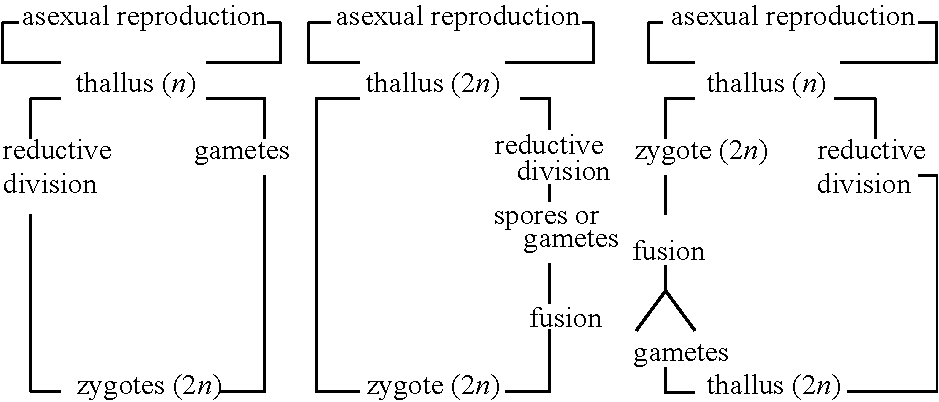 Haplobiontic A life cycle_Haplobiontic B________Haplobiontic C Fig. Life cycle of sexually reproducing fungi   Fig. Life cycle of Agaricus sp. (mushroom) Table. Saccardo's spore groups (Saccardo 1899) → Saccardo's system Subdivision Pucciniomycotina (サビキン)Class Pucciniomycetes (サビキン)Subdivision Ustilagiomycotina (クロボキン)Subdivision Agaricomycotina (ハラタケ)Class Tremellomycetes (シロキクラゲ)Class Dacrymycetes (アカキクラゲ)Class Agaricomycetes (ハラタケ)≈ Homobasidiomycetes (真正担子菌) (Hibbet et al. 2001)Order Agaricales Underw. 1899 (ハラタケ)> 400 species in 46 families |
Agaricaceae Chevall. (ハラタケ) 1340 species in 85 genera (Kirk et al. 2008) Agaricus L. (ハラタケ) A. campestris L. (ハラタケ, agaric, field mushroom or meadow mushroom), edible when young Bovista (ダンゴタケ) Calvatia (ノウタケ) Chlorophyllum (オオシロカラカサタケ) Coprinus (ササクレヒトヨタケ) Cystoderma (シワカラカサタケ) Cystolepiota (コナカラカサタケ) Lepiota (キツネノカラカサ) Leucoagaricus (シロカラカサタケ) Leucocoprinus (キヌカラカサタケ) Lycoperdon (ホコリタケ) Macrolepiota (カラカサタケ) Melanophyllum (アカヒダカラカサタケ) Ripartitella (ニセキツネノカラカサ) Tulostoma (ケシボウズタケ) Marasmiaceae (ホウライタケ) Marasmius Fr. 1836 (ホウライタケ) M. pulcherripes Peck (ハナオチバタケ) M. androsaceus (L.) Fr. (オチバタケ), syn. Gymnopus androsaceus (L.) J. L. Mata et R. H. Petersen Bolbitiaceae Singer (オキナタケ) Bolbitius (Pers.) Fr. (オキナタケ), Conocybe Fayod. (コガサタケ), Agrocybe Fayod. (フミヅキタケ), Pholiotina Fayod. (ツチイチメガサ), Panaeolus (Fries) Quél. (ヒカゲタケ), Panaeolina (ヒメシバフタケ) Maire
Arrhenia, Ampulloclitocybe, Camarophyllopsis (オトメノカサ), Camarophyllus, Cantharellula (ハイイロサカズキタケ), Chromosera, Chrysomphalina, Gliophorus, Haasiella, Hygrocybe (アカヤマタケ): H. turunda (Fr.) P. Karst. f. macrospora (Hongo) Hongo (キミズゴケノハナ), Hygrophorus (ヌメリガサ), Humidicutis, Lichenomphalia, Pseudoarmillariella Subdivision Incertae sedisEntorrhizomycetes, Wallemiomycetes |
| Spores | Name covering 1 and 2 | 1: Spores hyaline or bright (Hyalo-) | 2: Spores dark (Phaeo-) | |
| A | 1-celled (and not E, F, or G) | Amerosporae | Hyalosporae | Phaeosporae |
| B | 2-celled | Didymosporae | Hyalodidymae | Phaeodidymae |
| C | 2 or more cross septa | Phragmosporae | Hyalophragmae | Phaeophragmae |
| D | Muriform | Diotyosporae | Hyalodictyae | Phaeodictyae |
| E | Filiform | Sooleoosporae | ||
| F | Spirally coiled | Helioosporare | ||
| G | Star-like in form | Staurosporae |
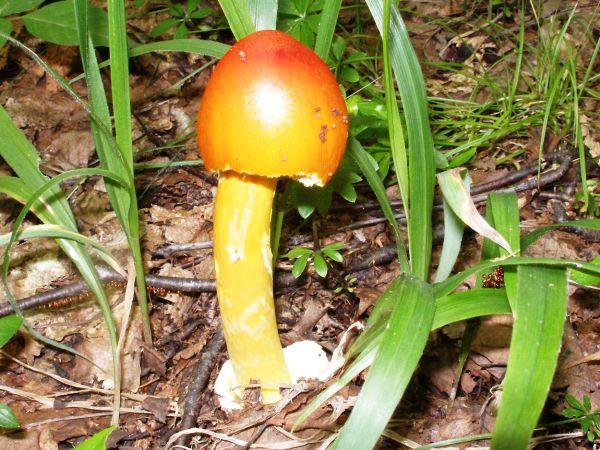 01
01
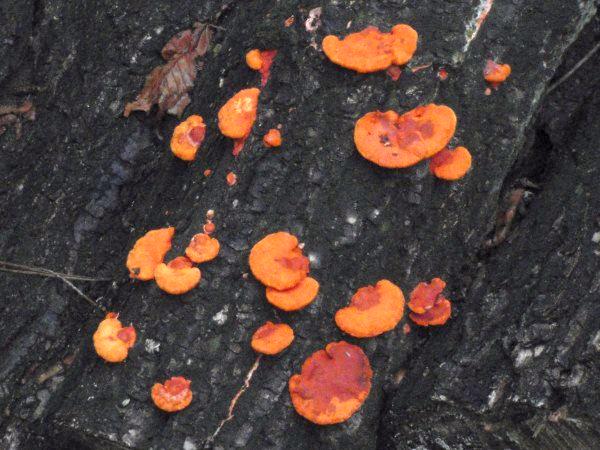 02
02
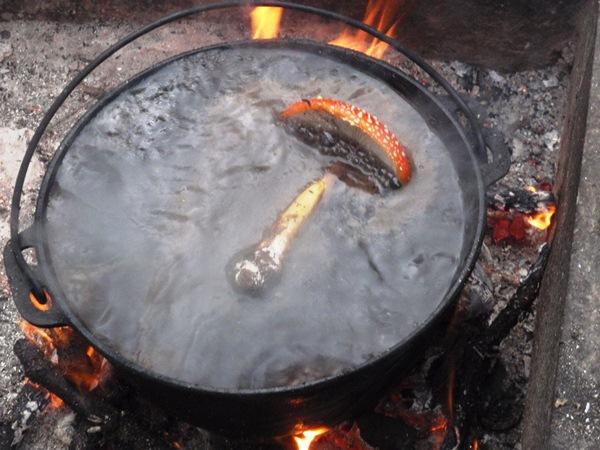 03
03
[1] Amanita hemibapha (Berk.et Br.) Sacc. (タマゴタケ) at Kofu-en, South Ward, Sapporo, on June 30 2009. [2] Pycnoporus coccineus (ヒイロタケ), on a log tree along a trail at Mount Namsan in Seoul City, Korea, on September 13 2012. [3] Amanita muscaria (L.) Lam. (ベニテングタケ) at Upper Chatanika Camp Site, Alaska, USA, on August 11 2010. Back: at the campus of Hokkaido University on October 7 2014.
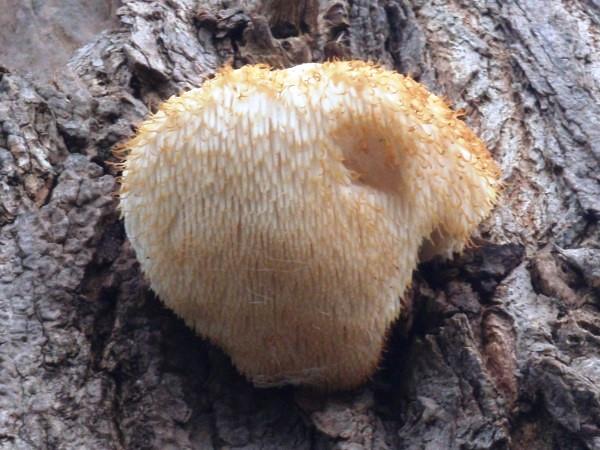 04
04
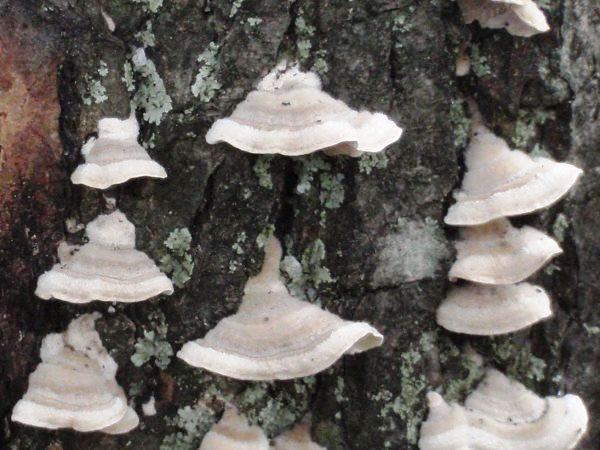 05
05
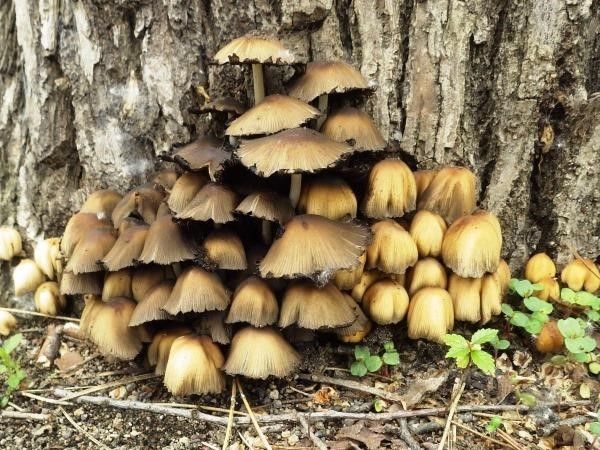 06
06
[4] Hericium erinaceum (Bull.) Persoon (ヤマブシタケ) at a street tree, N20/W3, North Ward, Sapporo, on October 8 2013. [5] Trichaptum biforme (Fr.) Ryvarden (ハカワラタケ) in a Hokkaido University Campus on September 11 2013. [6] Coprinellus micaceus (Bull.) Vilgalys, Hopple et Jacq. Johnson (キララタケ) at the base of an old Ulmus davidiana tree in the campus of Hokkaido University on June 21 2014. Also, seen on a few stumps at Nakayama Pass parking lot on August 27 2021.
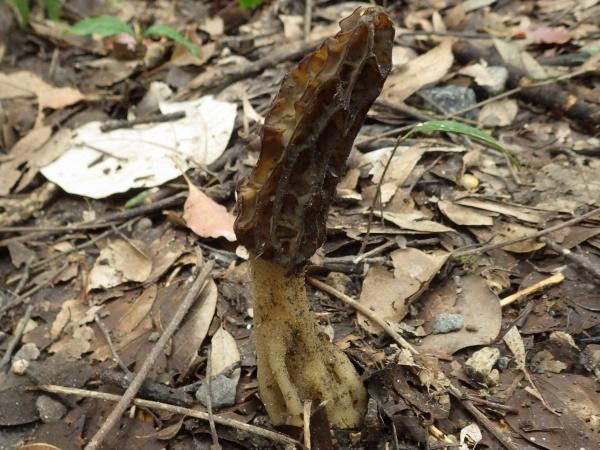 07
07
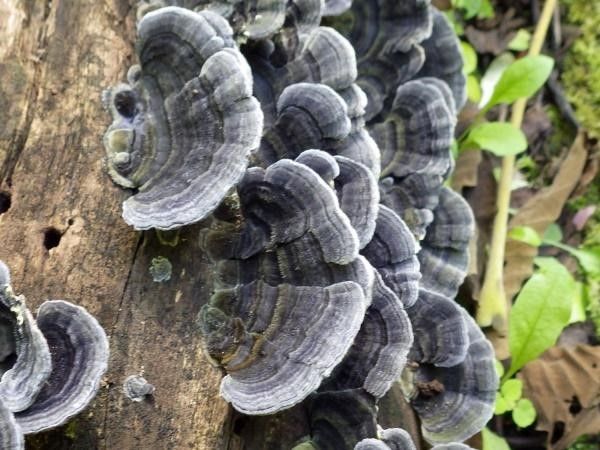 08
08
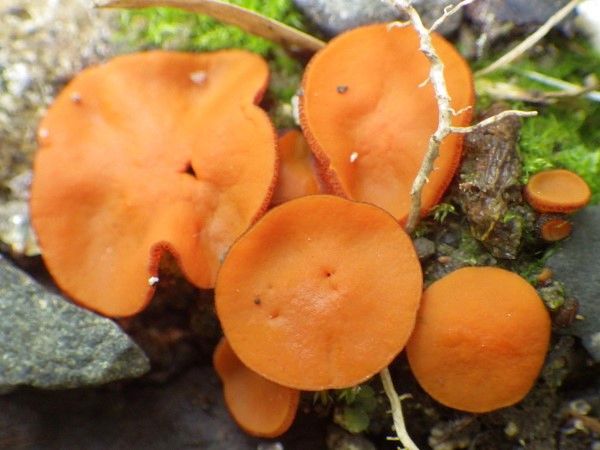 09
09
[7] Morchella esculenta (L.) Pers. (アミガサタケ) on Shiroyama nature road in Kagoshima City, southern Kyushu, on March 20 2015. (fairy ring) [8] Coriolus versicolor (L.) Quél. (カワラタケ, syn. Trametes versicolor (L.) Lloyd) in Tsukiura Forest Park near the Toya Lake Experimental Station of Hokkaido University on September 15 2015. [9] Aleuria aurantia (Pers.) Fuckel (ヒイロチャワンタケ) in the Furano Experimental Forest of the University of Tokyo, central Hokkaido, on June 28 2017
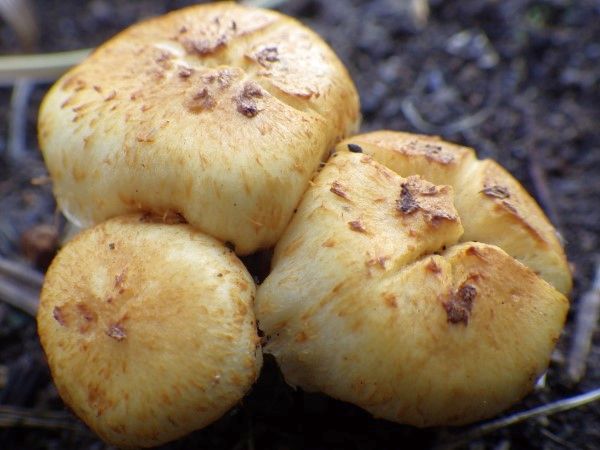 10
10
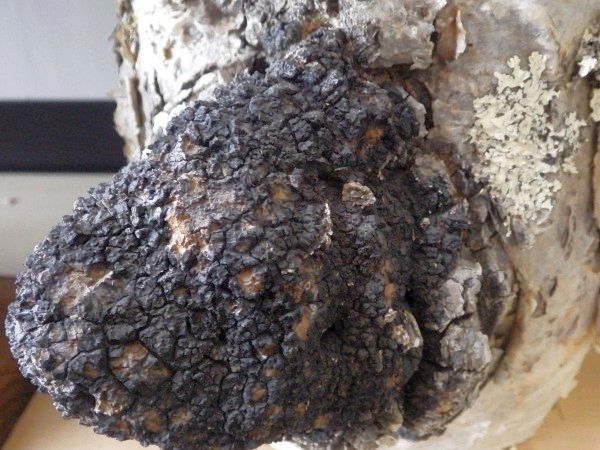 11
11
 12
12
[10] Pholiota terrestris Overholts (ツチスギタケ) that is poisonous on a lawn in the campus of Hokkaido University, Sapporo, on November 13 2017. [11] Fuscoporia obliqua (Ach. ex Pers.) Aoshima (カバノアナタケ) sample stored in the Uryu Experimental Forest, northern Japan, on June 28 2018. [12] Piptoporus betulinus (Bull.) P. Karst. (カンバタケ) grown on a stump of brich near the backyard of Japanese archery training hall, Hokkaido University, on September 8 2018.
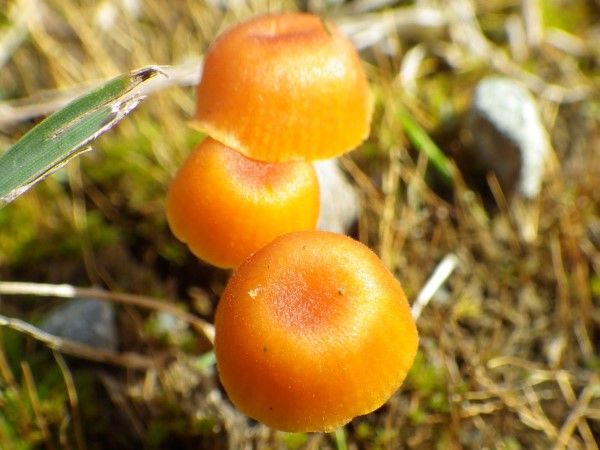 13
13
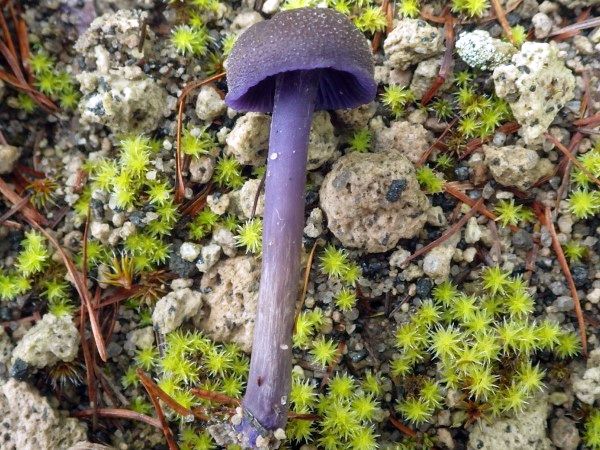 14
14
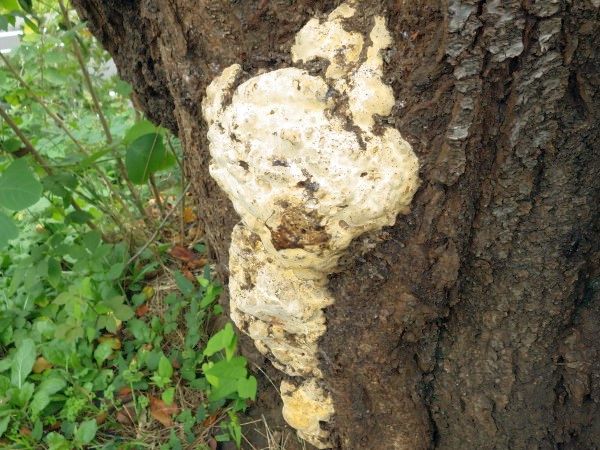 15
15
[13] Gerronema fibula (Bull.) Singer (ヒナノヒガサ) on a lawn in front of Sarobetsu Wetland Center on August 27 2018. [14] Laccaria amethystina (Huds.) Cooke (ウラムラサキ) near the parking lot of Mount Koma, southern Hokkaido, on July 9 2018. [15] Perenniporia fraxinea (Bull.) Ryvarden (ベッコウタケ) at the base of a large cherry tree on a bank along Sophia Street, Chiyoda Ward, Tokyo, on October 19 2018.
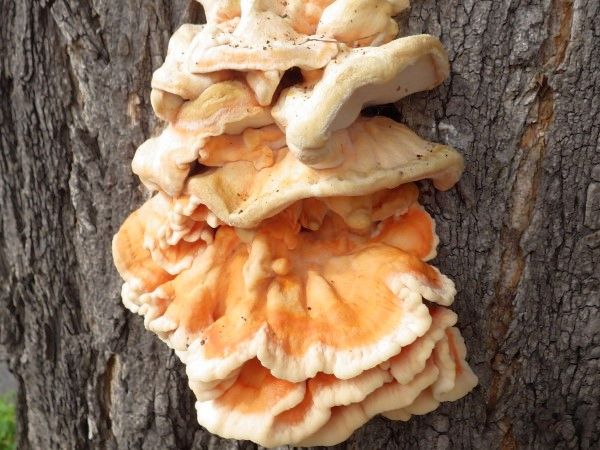 16
16
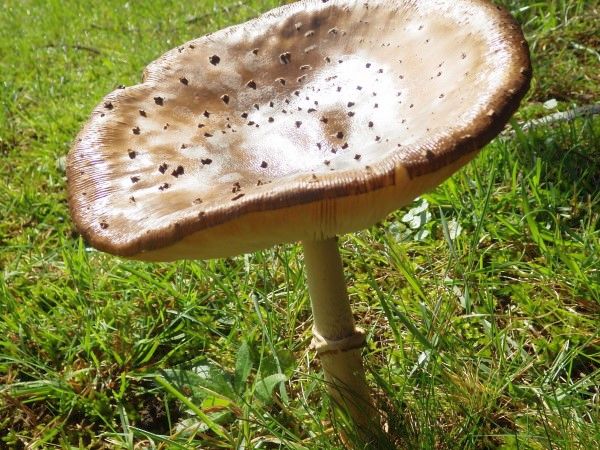 17
17
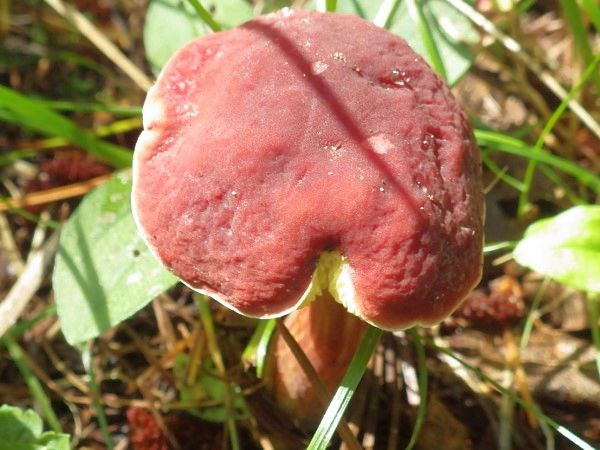 18
18
[16] Laetiporus sulphureus (Bull.) Murrill (アイカワタケ) on a tree (black locust) in N26/E1, East Ward, Sapporo, on September 7 2019. [17] Amanita pantherina (DC.: Fr.) Krombh. (テングタケ) in the Tomakomai Experimental Forest of Hokkaido University on September 12 2019. [18] Boletellus obscurecoccineus (Höhn.) Singer (ミヤマベニイグチ) in the Tomakomai Experimental Forest of Hokkaido University on September 12 2019.
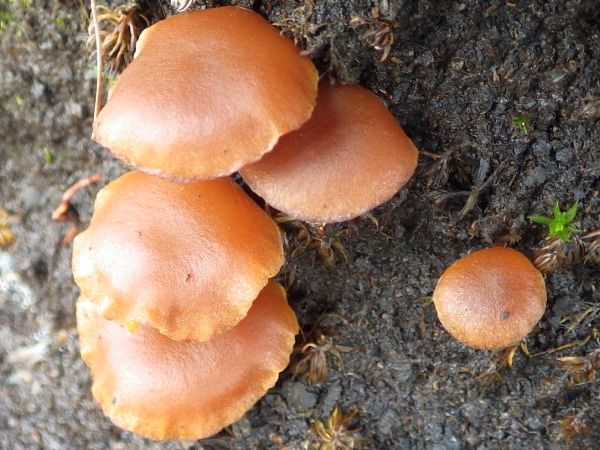 19
19
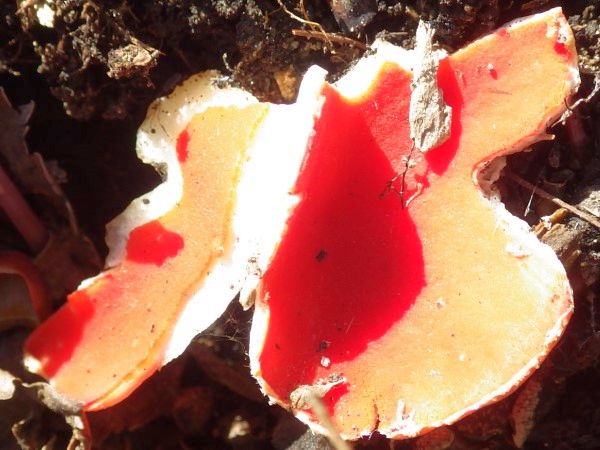 20
20
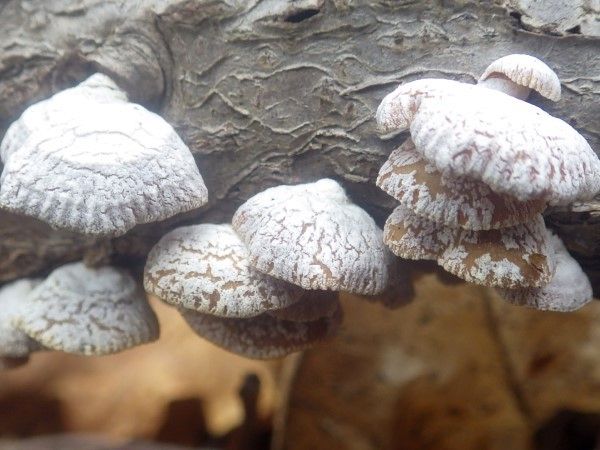 21
21
[19] Dermocybe cinnamomea (L.) Fr. 1838 (ササタケ) at the edge of tussock in a post-mined peatland, Sarobetsu mire, on August 20 2019. [20] Scutellinia scutellata (L.) Lamb. (ベニチャワンタケ) in the north campus of Hokkaido University on March 31 2020. [21] Crepidotus subsphaerosporus (J. E. Lange) Kühner et Romagn. ex Hesler et A. H. Sm. (ニセコナカブリ) on the south slope of Mount Usu on April 9 2020.
 22
22
 23
23
 24
24
[22] Coriolus polyzona (Pers.) Imaz. (キツネカワラタケ) on the south slope of Mount Usu on April 9 2020. [23] Fomitella fraxinea (Fr.) Imaz. (ベッコウタケ) on a stump in front of HU Coop Central Restaurant on August 11 2020. [24] Conocybe lactea (J. E. Lange) Metrod (キコガサタケ) near Ishikari Coast on the Road Station Ai-rodo (I-Road) in Atsuta on August 17 2020.